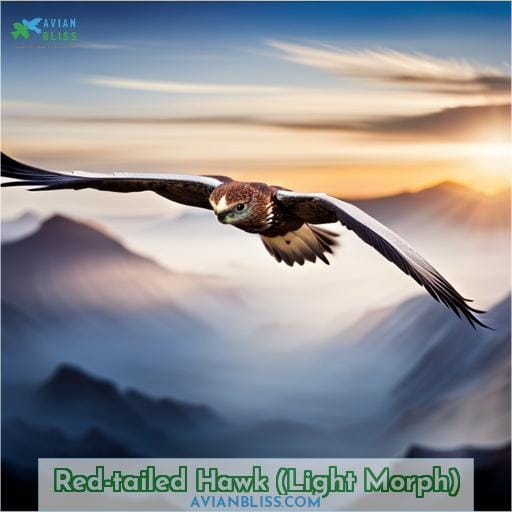This site is supported by our readers. We may earn a commission, at no cost to you, if you purchase through links.
 Stunningly beautiful and incredibly powerful, hawks with white bellies are a sight to behold.
Stunningly beautiful and incredibly powerful, hawks with white bellies are a sight to behold.
From Swainson’s Hawks in the north to Mississippi Kites in the south, these raptors capture our attention wherever they go.
In this guide we’ll identify nine of North America’s most common hawk species that have distinguishing white bellies – giving you all the information you need for successful identification!
So come along as we explore this incredible feathered family and their unique characteristics:
From wingtips extending past their tail tips at rest to broad wings narrowing or pinching slightly near their bodies; from gray heads and chestnut shoulders on perched birds, to black tails with white bands – each species has something special that sets it apart!
Table Of Contents
Key Takeaways
- Swainson’s hawk has a striped tail.
- The ferruginous hawk adapts to arid land.
- The white-tailed hawk inhabits the Texas coastal prairies.
- Displaying a rusty red tail is characteristic of the red-tailed hawk.
Hawks With White Bellies
You’ve glimpsed their graceful forms gliding above the prairie, those proud raptors with creamy breasts contrasting dusky wings. The white-tailed hawk is a marvel of avian engineering, with broad wings for effortless soaring and keen eyes that detect prey from on high.
Though wary of humans, they thrive in open spaces – hunting rodents, lizards, and insects on the wing. Their conservation status is secure, but habitat loss threatens populations. Two subspecies exist: hypospodius in the US and albicaudatus/colonus farther south.
In flight, note the dark primaries, white tail with a black band, and rufous shoulders for an ID. Appreciate their mastery of the skies, now clearer to you. With patience, you too may witness their aerial elegance.
Swainson’s Hawk
Hang tight bud, Swainson’s hawks have striped tail feathers and are found in open prairies.
- Migratory hawks that breed in western North America and winter in South America.
- Prey primarily on insects, small mammals, and reptiles.
- Population declined but now considered stable; protected under the Migratory Bird Treaty Act.
Known for their variability, Swainson’s hawks come in different color morphs. A dark morph has dark brown plumage with a white throat and flight feathers. The light morph has a dark head, breast, and flight feathers contrasting with a light belly and neck.
The intermediate morph shows a mix of light and dark feathers. Their long, striped tail feathers help identify them among the white-bellied hawks. Graceful soarers that hunt by coursing over open grasslands, Swainson’s hawks are declining in some areas due to habitat loss.
But with conservation efforts, these sleek prairie hawks continue flourishing across western North America.
Ferruginous Hawk
Least of all ’round here would I expect to spy that giant with tawny wings circling so low, friend. Yet the Ferruginous Hawk adapts to nest among the bushes and yuccas of this arid land. It slides on broad wings between scattered trees to take unwary prey. Its light color matches the grasslands, concealing fierce talons when hunting wary jackrabbits or ground squirrels.
With keen eyesight, it spies rodents from on high. Then it glides to the attack. Though this powerful, crow-sized raptor of open country finds sustenance here through opportunism, its prairie homeland shrinks steadily.
White-tailed Hawk
All along the Texas coastal prairies, ya see their graceful kiting flight style with dark wings and a white tail. White tailed hawks choose open country. Their wings extend beyond the tail when perched.
In flight, ya see lazy circles with V-shaped wings. Dark above with chestnut shoulders, white tail with a black band.
They nest in mesquite trees, laying 2-3 eggs. These hawks hunt by kiting 10-100 ft up, watching for prey.
Though widespread, they face threats like pesticides. Protecting prairie habitat will ensure their future.
We must appreciate their mastery of the skies.
Red-tailed Hawk (Light Morph)
You’d recognize the rusty red tail of the light morph Red-tailed Hawk as it soars over grasslands with V-shaped wings.
A common, widespread raptor, Red-tailed Hawks hunt small mammals like mice and rabbits from perches or while soaring. With powerful talons for grasping prey, these opportunistic hunters adapt to habitats from deserts to tropical rainforests.
Although populations are stable, habitat loss limits numbers in some regions.
Look for broad, rounded wings and that distinctive red tail as these hawks ride thermals and patrol open areas.
Success comes from patience – scanning for prey from a high vantage before swooping in for the kill.
Always observing, Red-tailed Hawks exemplify focus and determination. Their mastery of the skies is a model for attaining goals through persistence and vigilance.
Short-tailed Hawk (Light Morph)
You’ll notice its short tail and quick dives as this hawk hunts small animals in Central and South America. Found from Mexico south to Argentina, the Short-tailed Hawk prefers open country near forest edges.
As a light morph adaptation, its mostly white underside provides camouflage while hunting.
This agile flier excels at fast dives to surprise prey on the ground. The Short-tailed Hawk displays five key hunting techniques:
- Perch hunting – scans for prey while sitting on an elevated perch.
- Kiting – hovers in place using rapid wing beats to spot prey below.
- Low flight hunting – flies low and fast over the terrain, flushing out quarry.
- Quick dives – makes fast, steep dives from a height with wings tucked.
- Grabbing prey in flight – adept at catching birds in midair.
While superficially resembling the White-tailed Kite, the Short-tailed Hawk is easily distinguished by its bold black-and-white plumage, stockier build, shorter tail, and preference for ground hunting over aerial pursuits.
Northern Harrier (Adult Male)
You’ve got that sharp vision to spot the grayish-blue upperside of the gliding male Northern Harrier through the prairie grasses. With wings held in a dihedral, this slim raptor floats low over fields listening for rodents in the grass.
Using those owl-like facial disks, the harrier can snatch up mice and voles unseen.
This aerial hunter breeds in open wetlands, building a nest of sticks on the ground hidden in vegetation. By late summer, the harriers gather in loose flocks, migrating south in leapfrog fashion down the continent.
With those unique hunting habits, the harrier fills its own niche among other raptors like the sharp-shinned hawk.
| Adult Male | Adult Female | Juvenile |
|---|---|---|
| Grayish-blue upperside | Brown upperside | Brown upperside |
| White underside with black wingtips | Buff underside with brown streaks | Buff underside with brown streaks |
| Small white rump patch | Larger white rump patch | Larger white rump patch |
Swallow-tailed Kite
You spot a forked tail and know it’s that sleek bird, the swallow-tailed kite, soarin’ and swoopin’ with ease to snatch up a meal on the win’. Graceful and agile, this raptor rules the skies, effortlessly ridin’ thermals and makin’ acrobatic twists and turns chasin’ dragonflies, butterflies, small birds, and other tasty treats.
Though they breed up north, come fall swallow-tailed kites gather by the hundreds, migratin’ in flocks back down south to ride out winter. Contortionists of the air, their scissor-like tails let ’em pull off tight turns while huntin’.
Aerial masters that thrill with their aerobatics, you’ll know this bird’s joy of flight when you spy that forked tail slice across the sky.
White-tailed Kite
These raptors have red eyes that act like natural binoculars to spot prey at long distances.
They’re one of the only raptors that hover in midair while hunting. Using their long tail as a rudder, they can stay suspended for prolonged periods while scanning below.
White-tailed Kites are aerial acrobats that can swiftly change direction and orientation, even flipping upside down to grab prey from treetops and bushes.
They have specialized feathers that allow silent flight. This stealth gives them the element of surprise when ambushing prey on the ground.
Although their populations declined in the 20th century, increased use of conservation practices like no-till farming has allowed White-tailed Kite numbers to rebound in North America.
As you have learned, the White-tailed Kite is a unique and fascinating raptor well adapted to hunting in open habitats. With hawk-like agility and specialized hunting skills, this diminutive predator commands respect throughout its range in the Americas.
Gain a deeper appreciation for this raptor by observing its graceful flight in grasslands and agricultural areas.
Mississippi Kite
The Mississippi Kite is a sleek raptor that glides gracefully as it hunts insects and small animals in flight over open country. It has recently expanded its breeding range northward, with one pair nesting in a tall hackberry tree in our downtown city park last summer, surprising local birdwatchers who’d only seen it passing through during migration.
An aerial acrobat, the Mississippi Kite sails on long, pointed wings tipped with lengthy flight feathers ideal for its aerial hunting technique. It plucks flying insects out of the air and swoops down to snatch small vertebrates from grass and branches.
Social even in the non-breeding season, it migrates in flocks and nests in loose colonies. Though still uncommon across much of its range, the adaptable Mississippi Kite appears to be increasing and thriving amid human civilization.
As urban green spaces provide hunting grounds, this elegant raptor may become a more familiar sight overhead.
Conclusion
As you have seen, the variety of hawks with white bellies is truly remarkable. From the Swainson’s hawk with its striped tail feathers, to the Ferruginous hawk, which is the largest in North America and has a light morph, and the Mississippi kite, which is a sleek raptor and a skilled aerial hunter, these majestic creatures offer an awe-inspiring sight.
The white-tailed hawk, which is found primarily in Texas coastal prairies, is perhaps the most recognizable with its clean white breast and whiter underwings, short white tail with a dark tip, and broad pointed wings.
No matter what species of hawk with white bellies you may encounter, you can appreciate the beauty of these birds and the way they soar through the sky.












